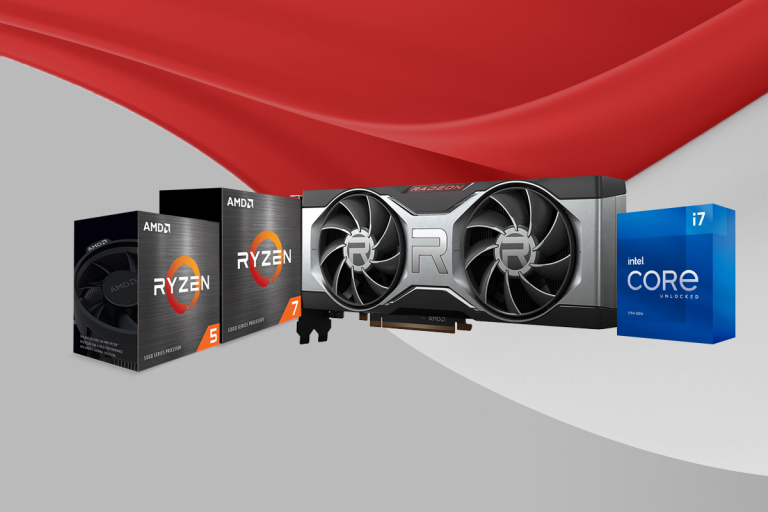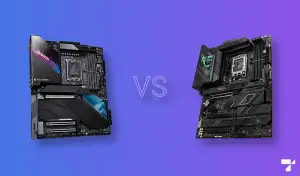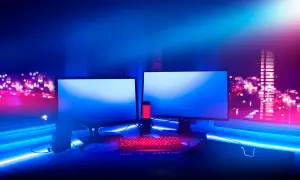The RX 6700 XT is one of the most popular graphics cards from AMD’s 6000 series. Based on the RDNA 2 architecture, and equipped with 40 ray tracing cores and 12GB GDDR6 RAM, this GPU can power most games at 1440p and 4K resolutions. However, for an optimal build, you’ll also need to pair the 6700 XT with a good CPU. Therefore, below we have a list of the best CPUs for RX 6700 XT.
The RX 6700 XT is a mid-range GPU that is comparable in performance with Nvidia’s RTX 3060 TI and RTX 3070. This graphics card is on its way to becoming one of the most popular, mainstream components on the market due to the amount of performance and versatility it provides. All the latest AAA games will work without a problem as long as you choose a good CPU as well. So let’s start exploring several budget-friendly, mid-range, and high-end processors that you can pair with your RX 6700 XT.
Best CPUs for RX 6700 XT
1. AMD Ryzen 5 5600X
Specifications:
Architecture: Zen 3 | Socket: AM4 | Cores/Threads: 6 / 12 | Base Frequency: 3.7GHz | Top Boost Frequency: 4.6GHz | TDP: 65WKey features:
- PCIe 4.0 for better graphics and storage bandwidth
- 7nm architecture
- 35MB total cache
- Wraith Prism Cooler with Razer Chroma support included
- AMD Ryzen Master Utility for simple overclocking
- AMD StoreMI technology
If you’re searching for the biggest bang for your buck CPU to go with the RX 6700XT, this 6-core processor is the ideal choice. The Ryzen 5 5600X rivals the performance of the i7 10700, but it’s cheaper.
Despite being more expensive than its previous generation counterpart, the 5600X offers excellent gaming performance, especially when paired with one of AMD’s new graphics cards, such as the RX 6700 XT. With a 3,7GHz base clock that can be boosted up to 4,6GHz, your system will be ready to handle the most demanding games out there. This processor works well for any gaming setup since most of the heavy lifting is nowadays done by the GPU, with some exceptions. On the downside, the 5600X isn’t an optimal choice for work like 3D rendering and other demanding processes.
All in all, the next-gen Ryzen 5 is equipped for the future by offering a lot of power in exchange for the low TDP of 65W. It’s also ready for PCIe 4.0, which will lower loading times and data transfer rates once more games and applications start taking advantage of it.
As a bonus for those who are restricted by their budget, the Ryzen 5 5600X comes with a solid cooler included. It might not be enough to keep the CPU cool if you overclock it to its maximum limit, but under normal gaming conditions, it will do its job.
2. AMD Ryzen 7 5800X
Specifications:
Architecture: Zen 3 | Socket: AM4 | Cores/Threads: 8 / 16 | Base Frequency: 3.8GHz | Top Boost Frequency: 4.7GHz | TDP: 105WKey features:
- PCIe 4.0 for better graphics and storage bandwidth
- 7nm architecture
- 36MB total cache
- AMD StoreMI technology
- AMD Ryzen Master Utility for simple overclocking
The Ryzen 7 5800X is one of the most popular choices for handling 3D rendering and other demanding workloads. It’s an excellent all-purpose processor thanks to its 8 cores and impressive 3.8 GHz base frequency that can be boosted up to 4,7GHz. However, that doesn’t mean it isn’t great for gaming. Quite the contrary. The 5800X is capable of handling any game, especially when paired together with a powerful GPU like the RX 6700 XT.
When it comes to features, just like the entire Zen 2 and Zen 3 lines of AMD processors, the 5800X supports PCIe 4.0. It also comes with some useful utilities we’re used to seeing in AMD CPUs. Overclocking is easy to achieve thanks to the user-friendly Ryzen Master Utility Tool, and the StoreMI technology boosts data transfer rates (as long as the motherboard supports StoreMI as well).
Overall, the 5800X is a jack-of-all-trades processor with powerful single-core as well as multi-core performance. You can’t go wrong by pairing it with AMD’s RX 6700 XT graphics card since the two components work together so well.
3. Intel Core i7-10700K
Specifications:
Architecture: Comet Lake | Socket: LGA 1200 | Cores/Threads: 8 / 16 | Base Frequency: 3.8 GHz | Top Boost Frequency: 5.10 GHz | TDP: 125WKey features:
- Can be overclocked up to 5.1 GHz using Turbo Boost Max 3.0
- Hyper-Threading technology
- Easy to use overclocking controls
- Intel Optane Memory support
If you’re looking for an 8-core alternative to the Ryzen series of processors, the i7-10700K is a great budget-friendly CPU from Intel. Despite being behind AMD when it comes to certain features, such as PCIe 4.0 support, the 10700K is a high-end processor that can handle any game and is good for serious work as well. With a 3.8GHz base frequency that can be boosted to a whopping 5.1GHz using Intel’s Turbo Boost Max technology, this i7 can compete with the more expensive i9 10900K for single-core performance. However, if you plan on heavily overclocking this CPU, make sure to purchase a high-quality cooler.
The largest downside, next to the lack of future-proofing, is the larger TDP. Intel processors still rely on an older, more demanding architecture. The 10700K requires 125W of power, so make sure to take that into account when purchasing your power supply, especially if you plan on overclocking.
4. AMD Ryzen 7 3700x
Specifications:
Architecture: Zen 2 | Socket: AM4 | Cores/Threads: 8 / 16 | Base Frequency: 3.6 GHz | Top Boost Frequency: 4.40 GHz | TDP: 65WKey features:
- PCIe 4.0 for better graphics and storage bandwidth
- 7nm technology
- 36MB total cache
- Wraith Prism Cooler with Razer Chroma support included
The Ryzen 7 3700x processor may be a generation old, but it still offers a lot of performance per dollar. It requires very little power with a TDP of 65W and with 8 cores and 16 threads it offers decent performance in multithreaded applications and games. Paired with the RX 6700 XT, you get a great mid-range computer without tearing holes in your pockets. The chip clocks at 3.6GHz that can be boosted to 4.4GHz, which makes it a great overall multicore CPU.
Despite being a generation old, the 3700x is still fairly future-proof. The architecture can’t be considered old and it offers PCIe 4.0 support.
All in all, the Ryzen 7 3700x is one of the cheapest multi-core processors out there that offer great single-core performance as well. It will handle 1440p resolution gaming quite well together with the RX 6700XT and you don’t need to worry about a GPU bottleneck.
5. AMD Ryzen 9 5900X
Specifications:
Architecture: Zen 3 | Socket: AM4 | Cores/Threads: 12 / 24 | Base Frequency: 3.7GHz | Top Boost Frequency: 4.8GHz | TDP: 105WKey features:
- PCIe 4.0 for better graphics and storage bandwidth
- 7nm technology
- 70MB total cache
- AMD StoreMI technology
- AMD Ryzen Master Utility for simple overclocking
If you’re a serious gamer and you spend a lot of time in front of your PC, you might want to get one of the best processors money can buy. The Ryzen 9 5900x is designed for enthusiasts. For the average user, it’s overkill with its 12 cores and 4.8GHz top frequency. It’s a gaming monster that can handle heavy workloads as well.
That being said, most games can’t use 12 cores. Most of them take advantage of 8 cores at best. However, that means if you invest in the 5900x you’ll have a computer that is still top-tier several years later. You’ll be able to fully enjoy 4K gaming, perform 3D rendering, and run any other demanding task. Just make sure to purchase a top-of-the-line cooler if you plan on overclocking because this CPU is a beast.
Overall, this is probably the best processor you can buy and pair with the RX 6700 XT graphics card. It offers excellent single-core performance as well as great multi-core performance, it has a large 70MB cache memory, and it only requires 105W of power.
6. Intel i9-10900KF
Specifications:
Architecture: Comet Lake-S | Socket: LGA 1200 | Cores/Threads: 10 / 20 | Base Frequency: 3.7GHz | Top Boost Frequency: 5.30GHz | TDP: 125WKey features:
- Thermal Velocity Boost technology for high overclocking
- New overclocking controls
- Hyper-Threading technology
First of all, you might be wondering what’s the difference between the 10900KF and 10900K CPU models. Simply put, the KF version comes without integrated graphics and is, therefore, a little bit cheaper than the K version. All the other specs and features are the same.
That being said, the i9-10900KF processor is Intel’s answer to AMD’s 3950x. It’s not a new processor and still relies on the old 14nm architecture. However, it’s still worth pairing it with the RX 6700 XT today because of the high core count and impressive overclocking capabilities it provides. This CPU peaks at 4.9GHz for all 10 cores, and 5.3GHz for single-core performance. Unfortunately, this amount of brute force translates to a high TDP of 125W that can go up to 250W if you’re overclocking the chip to its maximum capability. So make sure to invest in a serious power supply if you add this processor to your RX 6700 XT build.
Overall, the i9-10900KF is a powerful chip that can handle any game you throw at it. However, it lacks PCIe 4.0 support and it’s very power hungry when compared to the competition.
7. Intel Core i5-10600K
Specifications:
Architecture: Comet Lake | Socket: LGA 1200 | Cores/Threads: 6 / 12 | Base Frequency: 4.10 GHz | Top Boost Frequency: 4.80 GHz | TDP: 125WKey features:
- Turbo Boost 2.0
- Hyper-Threading technology
- New overclocking controls for more efficient tuning
- Intel Optane Memory support
When you think of budget PC builds, you have to consider the i5-10600K. It’s a classic 6-core CPU with an impressive 4.1GHz base frequency that can be boosted up to 4.8GHz. Together with the RX 6700 XT, this processor will take care of most of your gaming needs. However, if you intend to stream a lot or perform a series of demanding tasks, you should look into processors with a higher core count.
While this i5 offers a lot of performance at a low price, there are a few downsides to consider. Like all the other Intel processors on this list, there’s no PCIe 4.0 support, so future-proofing is out the window. But more importantly, this processor runs hot and demands a lot of power when overclocked. If you plan on getting as much performance as you can out of it, you’ll need a powerful PSU and a beefy cooler.
All in all, the 10600K CPU is great when paired with the RX 6700 XT. Your setup will be quite well-balanced and you can even enjoy 1440p gaming.
8. AMD Ryzen 5 3600X
Specifications:
Architecture: Zen 2 | Socket: AM4 | Cores/Threads: 6 / 12 | Base Frequency: 3.8GHz | Top Boost Frequency: 4.4GHz | TDP: 95WKey features:
- PCIe 4.0 for better graphics and storage bandwidth
- 7nm technology
- 35MB GameCache memory for boosted performance
- Wraith Prism Cooler with Razer Chroma support included
If you’re a casual gamer and you don’t perform any demanding tasks, such as rendering or video encoding, you should consider the highly affordable Ryzen 5 3600X. This 6-core processor can reach clock speeds up to 4.4GHz, supports PCIe 4.0, and comes with a decent cooler.
Despite being one generation old, it’s enough for the average gamer and PC user, especially when it’s paired with the RX 6700 XT graphics card. This processor won’t bottleneck the GPU, so no need to worry about that.
Overall, the 3600x is a budget-grade processor that carries its weight. However, you might want to consider the newer version, the 5600x, which is a bit more powerful and efficient. The price difference is marginal unless you find a good discount for the 3600x.
Final Thoughts
With AMD and Intel in fierce competition, we have plenty of options when it comes to CPUs. Whether you’re tight on a budget, or you’re an enthusiast looking to splash money on a multi-core monster, both manufacturers have something to offer. It all depends on what you’re going to use your PC for. All processors on this list work well with the RX 6700 XT GPU without causing any bottleneck issues and each one has its advantages and disadvantages.



